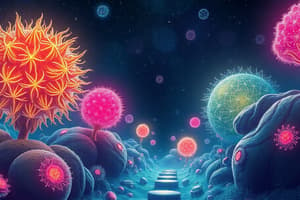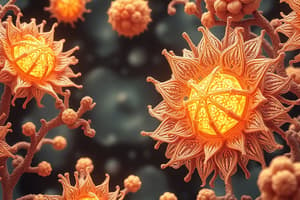Podcast
Questions and Answers
What defines protists in comparison to prokaryotes?
What defines protists in comparison to prokaryotes?
- They do not have a nucleus.
- They are eukaryotic and have a nucleus. (correct)
- They are unicellular only.
- They can photosynthesize only.
Which type of protist moves by extending cytoplasm or using a pseudopod?
Which type of protist moves by extending cytoplasm or using a pseudopod?
- Ciliates
- Sarcodines (correct)
- Sporozoans
- Zooflagellates
Which of the following protist groups is primarily composed of organisms that do not have movement?
Which of the following protist groups is primarily composed of organisms that do not have movement?
- Ciliaphorans
- Protozoans
- Sporozoans (correct)
- Zooflagellates
What type of nutritional mode do zooflagellates primarily exhibit?
What type of nutritional mode do zooflagellates primarily exhibit?
Which of the following protists is known to cause malaria?
Which of the following protists is known to cause malaria?
Ciliaphorans are characterized by which of the following features?
Ciliaphorans are characterized by which of the following features?
What types of organisms are classified as protists?
What types of organisms are classified as protists?
Which feature distinguishes zooflagellates from other types of protozoans?
Which feature distinguishes zooflagellates from other types of protozoans?
Which of the following statements accurately describes Protozoans?
Which of the following statements accurately describes Protozoans?
What defines Sarcodines among the various groups of Protozoans?
What defines Sarcodines among the various groups of Protozoans?
Which group of Protozoans is known for utilizing flagella for movement?
Which group of Protozoans is known for utilizing flagella for movement?
What type of organism is classified as a Sporozoan?
What type of organism is classified as a Sporozoan?
Which of the following correctly categorizes how Protozoans obtain nutrients?
Which of the following correctly categorizes how Protozoans obtain nutrients?
Which of the following is a characteristic feature of Ciliates?
Which of the following is a characteristic feature of Ciliates?
What function do zooflagellates serve in the digestive system of termites?
What function do zooflagellates serve in the digestive system of termites?
How do Protozoans generally reproduce?
How do Protozoans generally reproduce?
Which of the following descriptions is NOT true of Protozoans?
Which of the following descriptions is NOT true of Protozoans?
Which type of Protozoan is defined by being spore-forming and parasitic?
Which type of Protozoan is defined by being spore-forming and parasitic?
Flashcards are hidden until you start studying
Study Notes
Prokaryotes vs. Eukaryotes
- Bacteria are prokaryotes, meaning they do not have a nucleus or membrane-bound organelles.
- Protists are eukaryotes, meaning they have a nucleus.
Protists
- Mostly unicellular organisms.
- Not classified as plants or animals.
- Divided into four supergroups.
- Can be heterotrophs (animal-like), autotrophs (plant-like), or decomposers (fungus-like).
Protozoans (Animal-like)
- Unicellular, eukaryotic, heterotrophic protists.
- Can move.
1. Sarcodines
- Move by extending cytoplasm or a "false foot" called a pseudopod.
- Example: Amoeba.
2. Zooflagellates
- Use whip-like extensions called flagella for movement.
- Example: Trichmympha (lives in termite guts, helps digest cellulose), Trypanosama (lives in tsetse flies, causes African Sleeping Sickness).
3. Ciliates
- Largest group of protozoans.
- Bodies covered in tiny hair-like projections called cilia.
- Example: Paramecium.
4. Sporozoans
- Do not move.
- Spore-forming parasitic protozoans.
- Live by being parasites on or in animals.
- Can reproduce sexually and asexually.
- Example: Plasmodium (causes malaria).
- Immature sporozoans are called sporozoites and can be transmitted through fluids from one host to another.
Prokaryotic vs. Eukaryotic Cells
- Prokaryotes lack a nucleus and membrane-bound organelles
- Eukaryotes possess a nucleus and membrane-bound organelles
Protists
- Mostly unicellular organisms, but eukaryotic
- Previously classified in their own kingdom, Protista
- Now divided into 4 "Supergroups"
- Can either be heterotrophs, autotrophs, or decomposers
Protozoans (Animal-like Protists)
- Unicellular
- Eukaryotic
- Heterotrophs
- Motile
Sarcodines
- Move using cytoplasmic extensions called pseudopods
- Example: Amoeba
Zooflagellates
- Use whip-like flagella for movement
- Example: Trichmympha (digests cellulose in termites)
- Example: Trypanosama (causes African Sleeping Sickness, transmitted by tsetse flies)
Ciliaphorans (Ciliates)
- Largest group of protozoans
- Covered in tiny hair-like cilia for movement
- Example: Paramecium
Sporozoans
- Non-motile, parasitic protozoans
- Form spores
- Can reproduce sexually and asexually
- Example: Plasmodium (causes malaria)
- Immature sporozoans (sporozoites) are transmitted through fluids
Studying That Suits You
Use AI to generate personalized quizzes and flashcards to suit your learning preferences.




